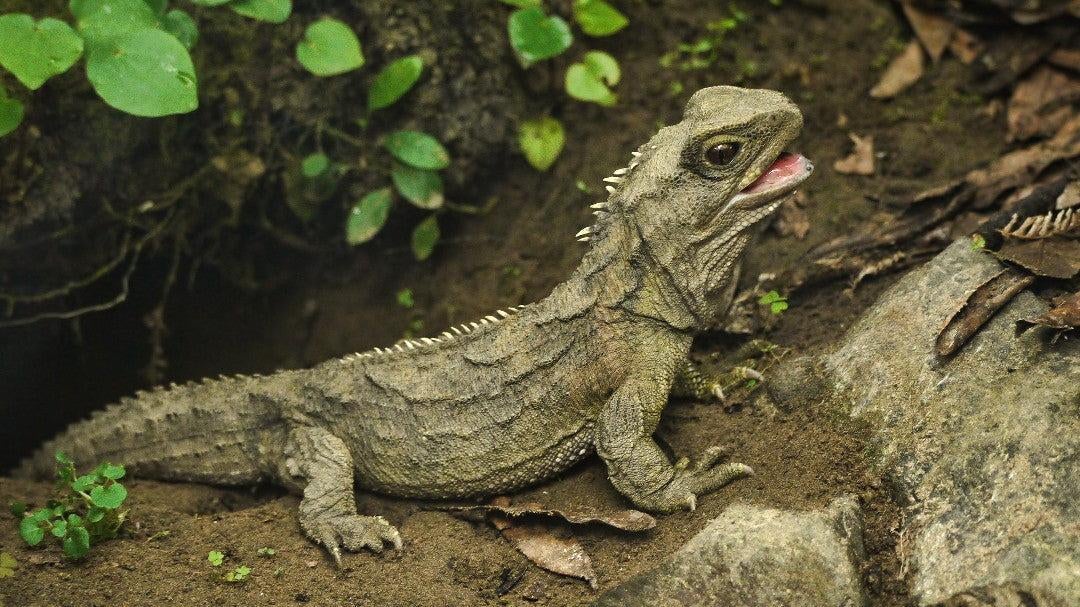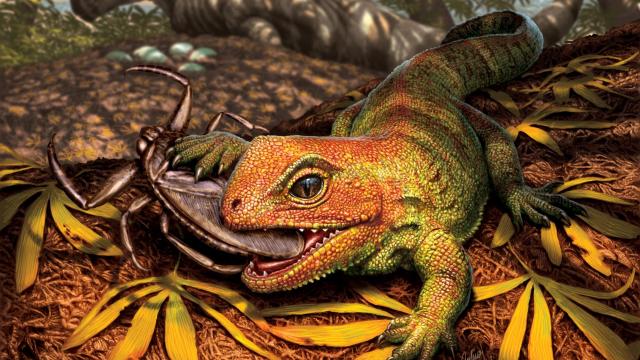150 million years ago, a prehistoric reptile unlike modern lizards slinked around what is now Wyoming. An ancient rhynchocephalian, the insect-eating animal’s discovery could shed light on the persistence of its living relative, the tuatara.
The reptile is named Opisthiamimus gregori. It looks like a lizard, but like New Zealand’s tuatara, it is not one. Lizards are squamates, an order of reptiles that includes snakes and worm lizards. Rhynchocephalians are a distinct group that diverged from lizards in the Triassic Period.
The fossils of Opisthiamimus come from Wyoming, where they sat above what was once an allosaurus nest. Paleontologists found four specimens at the site, including a nearly complete articulated skeleton of the reptile. The newly discovered species is described in a study published today in the Journal of Systematic Paleontology.
“What [the fossil] does is hammer home the fact that rhynchocephalians were a very diverse group for a lot of their evolutionary history,” said study co-author Matthew Carrano, the curator of Dinosauria at the Smithsonian’s National Museum of Natural History, in an email to Gizmodo. “There’s likely more ‘hidden diversity’ out there, because so many of the fossils are small and fragmentary, and hard to identify.”

Last year, scientists described a rhynchocephalian called Taytalura alcoberi, helping to clarify the evolutionary divergence between their reptilian order and squamates. Taytalura is only known from a well-preserved skull, but the younger Opisthiamimus has a nearly complete skeleton. Its discovery builds on that of Taytalura by showing that their reptilian order was diverse relatively early in deep time.
“I agree with the authors that this is an important finding from the Morrison Formation,” said Tiago Simões, an evolutionary biologist at Harvard University who was not affiliated with the recent paper, in an email to Gizmodo. Simões was one of the researchers who worked on Taytalura.
Opisthiamimus is very ancient; its existence precedes Tyrannosaurus rex by 60 million years. It lived in the late Jurassic, alongside Archaeopteryx and Stegosaurus (though much closer to the ground than the former two, and much smaller, measuring just 6 inches from nose to tail.)
The only extant rhynchocephalian is the tuatara, part of the subgroup called the sphenodonts, of which there are two species. The tuatara can live over 100 years and has the fastest-moving sperm of any reptile. It notably has a parietal eye in the centre of its forehead and three rows of teeth: two in its upper jaw and one in the lower. Unlike other reptiles, rhynchocephalian teeth are part of their jaws, rather than separate, replaceable elements.
Because of its unique anatomy, the tuatara is often referred to as a ‘living fossil.’ It has persisted when all other members of its order could not. But don’t call it primitive: It simply found a winning formula for survival and stuck with it.

“I would be cautious with the phylogenetic interpretation the authors provided for this species,” Simões added, noting that features of Opisthiamimus are more typical of sphenodontians that appear later in the fossil record.
Finding more fossils of the ancient reptiles could help explain why squamates persist on Earth in abundance while rhynchocephalians do not.
“One theory is that one or more of the unique features of squamates allowed them to outcompete rhynchocephalians,” Carrano said. “There’s a broad pattern of gradual decline in rhynchocephalians alongside a gradual increase in squamate diversity. But competition happens within environments, and right now we don’t have enough fossils to really investigate that idea, though in a place like the Morrison Formation we are getting close.”
Now, the team is sifting through the remains of the Allosaurus nest found just below Opisthiamimus. More rhynchocephalian fossils await discovery, in the Morrison Formation and beyond. When they come to light, they could help us unpack they reptilian family tree.
More: Rare Fossil of Triassic Reptile Discovered in Antarctica
